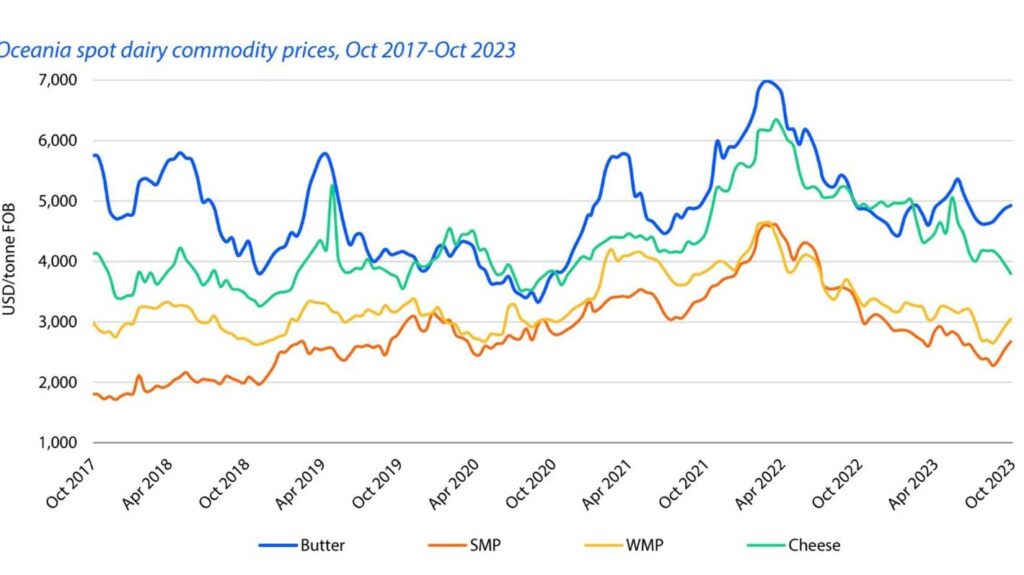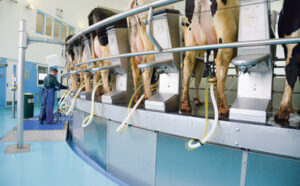
Dairy
There were some positive signs for Oceania dairy exporters in October, with commodity prices generally firmer. Oceania milk powder export prices rallied more than 10% for the month on the back of less favourable milk production signals in New Zealand. Butter prices also firmed through the month, but cheese prices fell again in October as a weak US wholesale market dragged prices lower.
Grey clouds continue to build over the production outlook in New Zealand. For the key month of September, milk production was 0.4% below the same month last year on a volume basis (but higher on a milksolids basis). This means that the volume of production for the season-to-date is trailing the previous season by 1%. Challenging seasonal conditions in the North Island have been the culprit.
In contrast, the milk production outlook in Australia has started the spring season in better shape and is translating into modest growth. For September, production was 1.5% higher than last year and is 1.5% higher season-to-date.
Elsewhere, US milk production has been in decline for the past few months, with a smaller herd driving the slowdown. Across Europe, milk supply growth remains sluggish and farmgate prices are showing signs of stabilisation.
What to watch
Signs of El Niño taking hold. Every El Niño weather pattern is different. This makes it difficult to predict its impact on farming regions.
USDA/Rabobank
Signs of life for the dairy complex
Beef
There is some good news for beef producers. A rise in bull prices has been stronger than average for this time of year. Prices, after being close to average back in September, are now 5% higher than the five-year average. US imported lean trimmings prices rose through September but have flatlined and dropped slightly in US dollar terms since late September. Meanwhile, the continued rise in New Zealand prices may reflect the seasonally lower volumes of cows and bulls in the system and the desire of processors to attract numbers with the anticipation of US prices remaining strong. That being the case, expect prices to continue tracking above the five-year average over the coming month.
Total beef slaughter volumes for the production season to the end of September were largely similar to the prior period. Provisional NZ Meat Board export slaughter data show bull slaughter was down 5% while steer slaughter was flat. Heifer slaughter was up 2% and cow slaughter was up 3%. Higher cow slaughter in the South Island reflects weaker milk prices and harder herd culling.
Annual beef export volumes for September were 5% lower. Volumes to China declined by close to 30% and value dropped by a significant 46%. However shipments to the US jumped 35% and values were up 22%, the result of US drought easing and corresponding domestic beef production dropping.
What to watch
Chinese demand. Chinese Lunar New Year is slightly later this year, on February 10, 2024. After the 2023 New Year failed to generate the expected jump in sales, this Lunar New Year period will be an important bellwether for setting expectations of Chinese appetite. The next couple of months will be a key for Chinese buyers. However with large amounts of product in store and a slow consumer market, demand may be soft, particularly if shortages in the US mean global prices are higher.
Sheepmeat
Unfortunately, there wasn’t much good news for lamb prices in October as prices continued to hover at similar levels to 2020.
Farmgate prices have seasonally peaked and new season lambs are about to come online. US import prices are holding for now and fortunately Australian production growth appears to have moderated. All eyes are firmly on demand from China as it heads into the buying period for the Lunar New Year.
Provisional NZ Meat Board export slaughter data for the season shows lamb slaughter was steady and mutton slaughter was down 9%.
Sheepmeat export data reflects the challenging market conditions in China. September shipments were up 2% but the value was down 17%, driven by the weaker value of shipments to China and the US, down 11% and 15% respectively.
What to watch
Australian production. Rain through southern parts of Australia in early October might just be enough to give producers the confidence to hold sheep and look for store lambs to fatten.
Ravensdown/Rabobank
No Middle East effect, so far
Fertiliser
We expect fertiliser prices to remain stable with a small bearish potential for major overseas exporters, assuming the Israel-Hamas war does not disrupt supply chains or boost crude oil prices. For the next five months, we forecast international urea prices to be down 11% in US dollar terms compared to the period between November 2022 and March 2023, with DAP prices down 26% and potash down 41%. However the weaker New Zealand dollar means the declines in local currency terms will be 4% for urea, 19% for DAP and 35% for potash.
What to watch
The Israel-Hamas war. The recent outbreak of violence in the region is taking place far from the Israeli mines, and no port activity has been suspended so far. Israel accounts for 8% of global phosphate exports and 6% of potash, and is active in speciality fertilisers like hydroponic solution ingredients. Not only is the fertiliser supply under threat, but also crude oil and natural gas, and thus, nitrogenous fertilisers. Egypt is a heavy player in this sector. A conflict escalation involving Egypt would flip the market.



